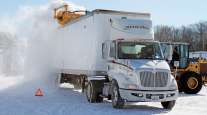N.Y. Closes Thruway Section as Snow, Bitter Cold Move to Eastern U.S.
New York Gov. Andrew Cuomo (D) has ordered trucks off the New York State Thruway in Western New York as of 3 p.m. Jan. 6 due to an anticipated snowfall of 3 feet.
The Thruway between Exit 55 at West Seneca and Exit 61 at the Pennsylvania line is closed to commercial vehicles, the governor said in a statement.
“The closure is a precautionary measure due to an extraordinary winter weather event that is forecast to include 36 inches of snow in the coming day-and-a-half, lake effect snows in some areas up to 4 inches per hour, wind gusts up to 40 miles per hour and wind chill temperatures as low as 40 degrees below zero,” Cuomo’s announcement said.
And starting at 8 p.m., all vehicles traveling westbound on the Thruway will be detoured off the roadway at Exit 50, located at Interstate 290 going west; and all eastbound traffic will be detoured off at Exit 61.
An extremely cold weather system and snow is blanketing much of the Midwestern and Eastern regions of the United States, including areas in the South.
The high temperature in Chicago will be below zero Fahrenheit Jan. 6, and Washington and New York will fall to 7, the National Weather Service reported. Dallas will hit 19, and the temperature in Orlando, Fla., may dip below freezing.
Officials in states including Indiana and Wisconsin have closed some roads and advised motorists to stay off all roads if possible.
The expected cold, along with a winter storm that hit Jan. 2-3, has caused many states to waive hours-of-service rules. As of Jan. 6, Arkansas, Massachusetts, New Jersey and Rhode Island were under HOS waivers for truckers hauling fuel.
Jan. 7 will be even worse for the East, NWS said.
“Cold temperatures and gusty winds associated with an arctic air mass will continue dangerously cold wind chills as far south as Brownsville, Texas, and Central Florida,” NWS said. The weather system will hit the Eastern two-thirds of the country, and 90% of the contiguous United States is likely to fall below freezing Jan. 6.



